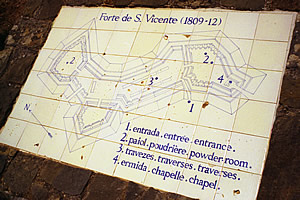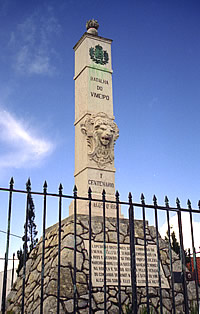


Lisbon has friendly people, great food and wine, one of the most impressive monuments in the world and is within easy reach of interesting palaces, castles and monasteries as well as Peninsular War battlefields.



Arriving late in the evening at Lisbon airport, and with a long delay in getting our hire car, it was almost dark when we set off to find our hotel. We had a very difficult time in the one-way systems but eventually managed to arrive by homing in on the approximate area with the help of the instructions sent to us previously by the hotel, and parking and scouting on foot. The Hotel Lisboa was very comfortable, with a pleasant bar which serves snacks and excellent port.

The following day we took the supertram to Belém and saw for the first time the magnificent Monument to the Discoveries. Made in the shape of a caravel it was erected in 1960 on the banks of the Tagus to commemorate the 500th anniversary of the death of Henry the Navigator who is standing on the prow - or, rather, a representation of him is standing on the prow! Also represented are Cabral (discoverer of Brazil), Magellan and Vasco da Gama who opened up the sea route to India and set sail from Belém.

Took so many photographs here, it's such a wonderful work of art.

Lisbon's prosperity is built on its relationship with the sea. Since Roman times it has been an important centre of trade but it wasn't until 1255 that it took over from Coimbra as capital. Its high point was the great age of discoveries in the fifteenth and sixteenth centuries when new trade routes were opened up

Henry did not sail on the ships but initiated the age of the discoveries by setting up a School of Navigation where the leading navigators, cartographers and seamen of Europe came to work. He was the third son of João and Philippa (of Lancaster - daughter of John of Gaunt) and was the Grand Master of the Order of Christ whose vast wealth Henry used to finance his maritime activities.



The Monastery at Belém - Mostero dos Jerónimos - was built as a tribute to Vasco da Gama's discovery of the sea route to India and is one of the few buildings in Lisbon to have survived the immense earthquake of 1755. It is a good example of the very decorative Manueline style of architecture and has lovely cloisters.
We were very lucky to be there at an impromptu recital by visiting choir "Main Street Singers" - unaccompanied "choral" and very beautiful.





The Tower of Belém is a very fine example of Manueline - the only complete one in Portugal. It was constructed between 1515 and 1520 - the last five years of the reign of Dom Manuel I - to guard the approach to the harbour.

The Tower sits virtually in the river, although at low tide the mud flats surrounding it are visible.


Personally I prefer the Tower to the monastery - it is less fussy and has a lovely Moorish influence - the architect Francisco de Arruda had previously worked on Portuguese fortifications in Morocco.


The Maritime Museum has beautiful ceremonial barges and models of Spanish Galleons, although for some reason the lifebelt underpants stick in the mind! It also has the seaplane Santa Cruz in which Sacadura Cabral, with Coutinho, made the first crossing of the South Atlantic in 1922 - there's a monument in the Tower of Belem gardens which is a replica of the plane.


The centuries-old Castelo de S. Jorge stands high above the city, and a steep climb is rewarded by fine views from its walls. It is Moorish in construction with castellated battlements and towers. After Lisbon was taken from the Moors in the twelfth century it was, for a while, the residence of Portuguese kings.





During Arab times the nearby Alfama district was the grandest part of the city. The steep streets lead down from the castle towards the Tagus.
This is the oldest part of the city and a very pleasant place to wander with its Moorish houses and winding, cobbled, narrow streets - probably quite easy to get lost.
Casa dos Bicos - a beautiful sixteenth century house with a facade made with diamond-shaped stones - was badly damaged in the 1755 earthquake but has been rebuilt.



Twice in our wanderings in the Belém district we had lunch at a riverside restaurant - Portugalia - which we thoroughly enjoyed. It has great views of the Monument to the Discoveries being right next to it! The traditional dish of pork Portuguese style - with fried eggs - and house wine followed by chocolate mousse and coffee for two cost around 5905 Escudos.

We also had an excellent chicken and chips in a small restaurant in the Baixa - the lower part of the city and heart of the business district. Called Rei dos Frangos it sits just off Rua das Portas de Santo Antao in a small alleyway - don't be put off by the exterior - the people are friendly and the food superb. Spit roast half chicken and chips, house wine for two with pineapple in port for one - 2950 escudos.
But by far the best meal we had in the city was at L'Entrecote in the Chaido district, to the west of Baixa. Simple but superb steaks with chips and excellent wines. Served by friendly white-aproned staff in a beautiful high ceilinged, panelled room. Sorbets to die for. 11050 Escudos for two.







A beautiful place for the summer residence of the Kings of Portugal, 24km by car from Lisbon.

Our first attempt at visiting the Palácio National at Sintra was foiled by it being closed at Easter! It was worth a return trip though (and the queijadas - custard tarts - in the local Café Paris are certainly worth two visits) as it has interesting kitchens with big chimneys (the conical outlets you can see in the exterior) and lots of small interior courtyards with pools which must have been very pleasant retreats in the heat of summer. Dating originally from the time of the Arabs, the current buildings are mostly due to Dom Joao I and his successor Dom Manuel in the fifteenth century.
People were walking up to Castelo dos Mouros but we drove!


Fantastic views from the walls, including to the Palácio da Pena.





It is the exterior of this palace which we found to be the greatest attraction - maybe we were a bit tired of state apartments! The fantastical colours, turrets, and castellated battlements mix Moorish, Manuelline and Medieval styles - definitely worth a trip. It was built by Ferdinand of Saxe-Coburg-Gotha, husband of Queen Maria II, in the great tradition of fantasy castles brought to a peak by King Ludwig of Bavaria.

Probably the best meal we had in Portugal was at Toca do Javali in São Pedro de Sintra. The wild boar was fantastic. 8710 Escudos for a two course meal with wine for two.





The coast north from Sintra is beautiful, with cliffs and sandy beaches.


Peniche is a bustling fishing town with a rocky coastline. The fortress was begun in 1557 and completed in 1645. It now houses an interesting museum, worth a visit for the cells, which once held political prisoners, and the underground water store for the fortress.

The very ornate 14th century Monastery of Batalha about 120km north of Lisbon, was under construction for over a hundred years and never actually completed. It houses the tombs of Dom João I and his wife Philippa of Lancaster.







Alcobaça, a Cistercian Monastery about 100km north of Lisbon, was founded in 1153 by Dom Henrique to celebrate victory over the Moors in 1147. Probably the best example of Portuguese Gothic, it is much more interesting inside than Batalha. The kitchens in particular, with their over-sized chimneys and sinks, are fantastic. It also had a large pool, fed by constantly running water diverted from the riiver, where fish were kept.


The Monks' refectory has an impressive pulpit and a curious narrow doorway said to be a test for obesity - can't get through? - no dinner!



Between 1808 and 1814 the Iberian Peninsula was the setting for a series of military campaigns which culminated in the French Army being driven back across the Pyrenees by a British-Portugese-Spanish alliance.

The Peninsular War is notable for the emergence of Arthur Wellesley as a great military commander. Although Wellesley's most celebrated victories over the French came in Spain at Salamanca (1812) and Vitoria (1813), the sites of earlier Wellesley victories at Roliça (1808) and Vimeiro (1808) are within easy reach of Lisbon by car. Fort São Vicente, one of the forward fortifications in Wellesley's defensive Line of Torres Vedras, is also worthy of a visit.


The series of fortifications known as the Lines of Torres Vedras were constructed at Wellesley's orders between November 1809 and September 1810 and provided a practically impregnable barrier stretching from the Atlantic to the River Tagus. The best-known remains of the Lines are those of the Fort São Vicente, just outside the town of Torres Vedras, 45km by motorway north of Lisbon.




Vimeiro lies a short distance north of Torres Vedras and is a 60km drive from Lisbon, most of which is by motorway.
The battlefield, where Wellesley defeated a French army led by Junot on 21st August 1808, is unfortunately
In the memorial park overlooking the battlefield near the town cemetery is a monument to the battle and a very nice ceramic tile depiction of the action.




Obidos is a pretty, small town about 70 km north of Lisbon which was traditionally presented by the Portuguese kings to their brides. It has lovely views from its walls which are complete. It is possible to walk all around the walls but it is a bit difficult in places.
South of Obidas is the Battlefield of Roliça It is not easy to explore but one of the most accessible bits is the memorial to Lt.-Col. Lake:
The inscription on Lt. -Col. Lake's memorial reads:
SACRED
TO THE MEMORY OF THE HON
LIEUT COL G A F LAKE OF THE
29 REG WHO FELL AT THE HEAD
OF HIS CORPS IN DRIVING THE
ENEMY FROM THE HEIGHTS OF
COLUMBEIRA ON THE 17 AUG 1808
THIS MONUMENT IS ERECTED BY HIS
BROTHER OFFICERS AS A TESTIMONY
OF HIGH REGARD AND ESTEEM.
